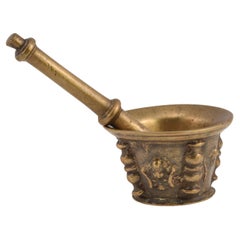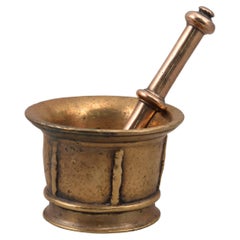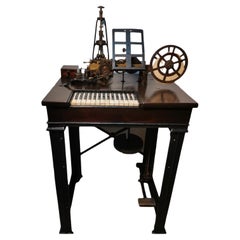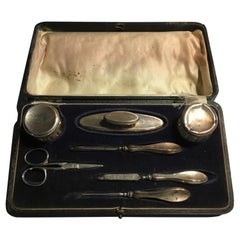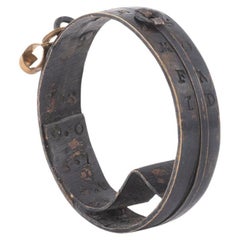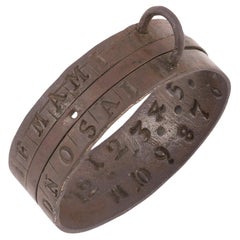Europe Scientific Instruments
7
to
2
7
7
7
7
7
97
93
33
29
19
16
15
12
8
7
7
6
5
3
3
3
1
4
3
6
2
1
1
1
7
2
2
1
1
1
1
Item Ships From: Europe
Style: Baroque
Mortar with pestle. Bronze. Spanish school, 17th century.
Located in Madrid, ES
Mortar with pestle. Bronze. Spanish school, 17th century.
Bronze mortar with a convex mouth, a raised base facing outwards and a cylindrical body decorated on the outside with relie...
Category
17th Century Spanish Baroque Antique Europe Scientific Instruments
Materials
Bronze
Alnmått (Cubit measure) in iron with gilded details. Baroque, dated 1731
Located in Knivsta, SE
Swedish Alnmått (Cubit measure) in iron with gilded details. Baroque, dated 1731. Provenance: Baron Carl Emanuel Cederström, great collector during the mid-19th Century in Sweden.
W...
Category
1730s Swedish Baroque Antique Europe Scientific Instruments
Materials
Iron
Bronze Mortar with Pestle, Spain, 17th Century
Located in Madrid, ES
Mortar with hand. Bronze. XVII century.
Mortar with a circular base, cylindrical body and slightly outwardly flared mouth, decorated with a series of smooth horizontal moldings arranged both in the lower and upper areas and with simple vertical elements (which still maintain slight balustraded shapes) derived from of the ribs that these specimens used to have in the medieval Spanish...
Category
17th Century Spanish Baroque Antique Europe Scientific Instruments
Materials
Bronze, Other
Mechanical Equatorial Sundial, Johann Michael Bergauer, Ante 1745
By Johann Michael Bergauer
Located in Milano, IT
Johann Michael Bergauer (Simonsfeld, 1676 - Innsbruck, 1745 circa)
Mechanical equatorial sundial
Signed: Michael Bergauer Insprugg? Innsbruck?
Ante 1745
Gilded and silvered brass; glass.
Measures: closed 1.29 x 3.50 x 4.92 in (33 x 89 x 125 mm); open 5.19 x 3.50 x 3.81 in (132 x 89 x 97 mm).
Weight: the sundial 0.49 lb (224 g); the case 0, 20 lb (95 g)
Original wooden case covered in brown leather.
State of conservation: very good. It has some signs of use. The spring that allowed for the two parts of the instrument to remain open is missing (absent even in the comparative specimens kept in museums).
The sundial is composed of two overlapping plates hinged together on the north edge.
The base plate is octagonal and is supported by three turned legs. The upper face is gilded and a compass with a magnetic variation index has been inserted. The rest of the surface is occupied by a rich decoration of engraved scrolls, centered around the inscription “Michael Bergauer Insprugg”. A foldable oval support with a plumb-bob is attached with a hinge on the southern edge. On the reverse of the base plate a table of the latitudes of some European cities (expanded with the vertical writing “Meiland 40” on the edge and “Rome” deleted) and of Jerusalem has been engraved. A Cam marked for 0 °-70 ° is applied near the northern edge. This can be adjusted to change the inclination of the upper plate according to the latitude; originally a spring, now lost, made it possible to keep the two plates of the clock open.
The second plate is round, has a toothed edge and measures 3.26 in (83 mm) in diameter: it is slightly smaller than the octagonal base which it rests upon and overlaps when the instrument is closed.
The recto is gilded and there are three concentric graduated circles engraved on it:
- the outermost is the equatorial hour dial, numbered I-XII, I-XII;
- the second-one is that of days 1-30 of the lunar month and has “Aetas lunae” engraved on it;
- the third, silvered, is a subsidiary hour dial, with double numbering 1-12; originally it could have been rotated.
The engravings of the first two circles are enameled in red.
In the center - on the polar axis - there is an alidade, at the end of which is associated the silvered minute dial. This, in turn, is welded, perpendicularly, to a small disc, also silvered, with a triangular gnomon. The plate, alidade and minute dial are connected to each other by toothed mechanisms.
Below is the procedure for measuring the time:
1) Adjust the Cam under the base of the clock, based on the latitude of your location;
2) Place the watch on a flat surface using the plumb-bob and with the side closest to the compass facing south;
3) Keeping the instrument still, manually rotate the alidade until the shadow cast by the triangular gnomon on the small silvered disc falls on the line marked below it;
4) The hour and minutes can therefore be read on the hour and minute dials set on the alidade respectively.
Johann Michael Bergauer, who sometimes only signs his works as Michael Bergauer, was born in Simonsfeld, north of Vienna. His apprenticeship as a watchmaker took place in Landshut and he probably worked as a laborer in Augsburg before becoming a watchmaker at the court of Karl Philipp von der Pfalz in Innsbruck in 1708. In the following years, his repeated attempts to obtain Innsbruck citizenship are documented and, in 1721, he is listed as a resident. In 1724 he was admitted to the guild of watchmakers, with which however he had continuous problems. In 1732 he presented a "masterpiece". This is the last reference to his business; he must have died before or in 1745 because in that year his widow appealed to the City Council.
The mechanical sundial...
Category
1730s Austrian Baroque Antique Europe Scientific Instruments
Materials
Brass
Hughes Telegraph Set Built by Siemens & Halske 19th Century
By Europa Antiques
Located in Madrid, ES
Hughes typewriting telegraph .A Printing Telegraph Set built by Siemens & Halske .This teletyper was invented by David Edward Hughes in 1856.Good condicion overall.Similar telegraph ...
Category
19th Century German Baroque Antique Europe Scientific Instruments
Materials
Wood
London Mid-19th Century Vanity Kit Set Sterling Silver
Located in Brescia, IT
Not easy to find this original box, with this kit set composed of 8 pieces for nail manicure. A piece to collect or to add in a wunderkammer.
In sterling silver, all marked.
With ce...
Category
Mid-19th Century British Baroque Antique Europe Scientific Instruments
Materials
Crystal, Sterling Silver
19th Century, J. Florenz Wien Chrome Steel Austrian Balance, 11 Brass Weights
Located in Vigonza, Padua
19th century, chrome steel Austrian balance, by J. Florenz Wien, 11 brass weights, 5 kg.
This precious antique table scale was from the famous Caffè Florian in Venice
Caffè Florian is a historic café in the city of Venice, located under the arcades of the Procuratie Nuove in Piazza San Marco.
It is the oldest Italian coffee and the oldest coffee in the world. It was inaugurated on December 29, 1720 by Floriano Francesconi with the name of Alla Venezia Trionfante, but immediately the Venetians simply said “andemo da Florian-let's go to Florian”, from the name of the owner in the Venetian dialect. Since then it has continued its daily coffee business uninterruptedly to the present day, becoming a favorite destination for Venetians, Italians and foreigners. Floriano Francesconi inspired the character of Ridolfo in Carlo Goldoni's coffee shop.
Giacomo Casanova courted the ladies there and Carlo Goldoni entered as a boy. Famous people such as Gasparo Gozzi, Giuseppe Parini, Silvio Pellico, Lord Byron, Ugo...
Category
1850s Austrian Baroque Antique Europe Scientific Instruments
Materials
Steel
Related Items
French 18th Century Baroque Wooden Madonna with Child
Located in Buisson, FR
Beautiful weathered oak Madonna with child, France, circa 1750. Weathered.
Measurement includes the wooden base.
Category
18th Century French Baroque Antique Europe Scientific Instruments
Materials
Oak
19th Century Bocce Balls, France, Set of Three
Located in Point Richmond, CA
Late 19th to early 20th century bocce balls, France, set of three
boxwood, iron and brass nails.
The first ball has the letters PP in brass, the second ha...
Category
Late 19th Century French Folk Art Antique Europe Scientific Instruments
Materials
Brass, Iron
19th Century Steel and Sterling Silver Malaysian Dagger
Located in Miami, FL
19th century sterling silver Malaysian Dagger.
Original carved mahogany wood handle.
Sterting silver carved crown.
Damascene steel.
The kris is an asymmetrical dagger with distincti...
Category
15th Century and Earlier Malaysian Malayer Antique Europe Scientific Instruments
Materials
Mahogany
Plaster Altar Angels, 19th Century
Located in Savannah, GA
A pair of polychromed plaster altar angels, France or Belgium, late 19th century.
11 inches wide by 10 inches deep by 20 ¼ inches tall
Category
Late 19th Century Belgian Baroque Antique Europe Scientific Instruments
Materials
Gesso, Wood, Paint
Frog Game Antique Brass Collectibles and Curiosities Spain Early 20th Century
Located in Mombuey, Zamora
Beautiful brass frog game set very nice
They are the pieces of the popular frog game
These originally would be mounted on a piece of furniture, but it is...
Category
Early 20th Century Spanish Other Europe Scientific Instruments
Materials
Brass
H 5.12 in W 6.3 in D 3.94 in
19th Century Baroque Style Baptismal Charger in Brass
Located in Haddonfield, NJ
A 19th century baptismal plate in brass with beveled flower decoration to celebrate the birth of the infant.
The dish can be wall-mounted.
Category
Mid-19th Century European Baroque Antique Europe Scientific Instruments
Materials
Brass
Blue and White Dutch Delft Tile with Carnation, 17th Century
Located in AMSTERDAM, NH
The Netherlands
Circa 1660 – 1680
A blue and white Dutch tile with the decoration of two carnations. One in the bud and one in bloom.
With small oxheads as corner decoration.
The t...
Category
1660s Dutch Baroque Antique Europe Scientific Instruments
Materials
Ceramic, Majolica, Faience
Free Shipping
H 4.89 in W 4.89 in D 0.44 in
Spanish Baroque Sunburst Mirror Miniature in Gold Leaf Gilded Wood
Located in Barcelona, ES
Antique Spanish Baroque carved giltwood sunburst mirror with crest. Spain, 19th century.
This lovely collection mirror has a carved frame covered with gesso and gold leaf finishing....
Category
19th Century Spanish Spanish Colonial Antique Europe Scientific Instruments
Materials
Gold Leaf
17th Century Dutch Delft Tile in Chinese Wanli Style with bird
Located in AMSTERDAM, NH
The Netherlands
Circa 1620 – 1640
A blue and white Dutch tile with a decoration of a Chinese garden with a bird on a rock. Influenced by the Chinese porcelain from the Wanli Period....
Category
1620s Dutch Baroque Antique Europe Scientific Instruments
Materials
Ceramic, Majolica, Faience
Free Shipping
H 5.16 in W 5.16 in D 0.48 in
French, 18th Century, Baroque Gilded Metal Procession Cross
Located in Buisson, FR
Beautiful baroque gilded metal procession cross with a great patina.
France circa 1750. weathered and small losses.
Measurements include the wooden pedestal.
Category
18th Century French Baroque Antique Europe Scientific Instruments
Materials
Iron
17th / 18th Century Italian Wooden Foot of a Santos
Located in Buisson, FR
Wonderful decorative item.
Italy circa 1650-1750
Weathered.
Category
17th Century Italian Baroque Antique Europe Scientific Instruments
Materials
Oak
Blue and White Dutch Delft Tile with Pikier, Mid 17th Century
Located in AMSTERDAM, NH
The Netherlands
Amsterdam
Circa 1625 – 1650
A blue and white Dutch tile with a decoration of a Dutch soldier from the period of the 80 Years War. This soldier could be a member of t...
Category
1620s Dutch Baroque Antique Europe Scientific Instruments
Materials
Ceramic, Faience, Majolica
Free Shipping
H 5.12 in W 5.12 in D 0.52 in
Previously Available Items
An Early 18th-Century Bronze Ring Sundial
Located in Firenze, IT
SHIPPING POLICY:
No additional costs will be added to this order.
Shipping costs will be totally covered by the seller (customs duties included).
Unsigned, but probably early 1700'...
Category
Early 18th Century Italian Baroque Antique Europe Scientific Instruments
Materials
Bronze
An Early 18th-Century Bronze Ring Sundial
Located in Firenze, IT
SHIPPING POLICY:
No additional costs will be added to this order.
Shipping costs will be totally covered by the seller (customs duties included).
Unsigned, but probably early 1700'...
Category
Early 18th Century Italian Baroque Antique Europe Scientific Instruments
Materials
Bronze
Bronze Mortar with Pestle, Spain, 17th Century
Located in Madrid, ES
Mortar with hand Bronze. Spain, 17th century.
Mortar with pestle made of bronze. The mortar has a circular base with projection, a cylindrical body and a mouth exvased to the outsi...
Category
17th Century Spanish Baroque Antique Europe Scientific Instruments
Materials
Bronze
Italian Mobile Bar Globe, End 19th / Early 20th Century
By Europa Antiques
Located in Madrid, ES
Italian mobile bar globe, end 19th / early 20th century
Measures : H: 103 cm x 79cm
very good condition
paint wood.
Category
Late 19th Century Italian Baroque Antique Europe Scientific Instruments
Materials
Wood
Pharmacy mortar. Bronze. Spain, dated in the piece in 1743.
Located in Madrid, ES
Pharmacy mortar. Bronze. Spain, dated in the piece.
Pharmacy mortar made in bronze with mouth exvased to the outside from the last third of the piece ...
Category
1740s Spanish Baroque Antique Europe Scientific Instruments
Materials
Bronze
Bronze Mortar with Pestle, 17th Century
Located in Madrid, ES
Mortar with hand bronze. XVII century.
Bronze mortar with curved mouth and frustoconical body decorated on the outside with some balustraded reliefs derived from the traditional ri...
Category
17th Century Spanish Baroque Antique Europe Scientific Instruments
Materials
Bronze
Bronze Mortar with Pestle, 17th Century
Located in Madrid, ES
Mortar with hand bronze. XVII century.
Bronze mortar with an exvased mouth and foot and a frustoconical body decorated on the outside with some balustraded reliefs derived from the...
Category
17th Century Spanish Baroque Antique Europe Scientific Instruments
Materials
Bronze
Bronze mortar with pestle. Spain, 17th century
Located in Madrid, ES
Mortar with hand Bronze. Spain, 17th century.
Bronze mortar with an exvased mouth and a frustoconical body decorated on the outside with some balustraded reliefs derived from the tr...
Category
17th Century Spanish Baroque Antique Europe Scientific Instruments
Materials
Bronze
19th Century Surgery Box
By Europa Antiques
Located in Madrid, ES
19th CENTURY SURGERY BOX
SOME INSTRUMENT IS MISSING-SEE PHOTOS. THE BOX MEASURES:45X17X18 CM
Good condition.
Category
19th Century English Baroque Antique Europe Scientific Instruments
Materials
Metal
Bronze mortar with pestle. Spain, 17th century
Located in Madrid, ES
Mortar with hand. Bronze. Spain, 17th century.
Bronze mortar with a flared mouth, an outwardly raised base and a cylindrical body decorated on the outside with reliefs alternating h...
Category
17th Century Spanish Baroque Antique Europe Scientific Instruments
Materials
Bronze
Bronze mortar with pestle. Spain, 17th century.
Located in Madrid, ES
Mortar with hand. Bronze. XVII century.
Mortar with a circular base, cylindrical body and mouth slightly flared outwards, decorated with a band of stars on the upper part and, on the front, alternating heraldic shields under an open crown (two quarters with two castles or towers and a lion or beast through below) with vertical balustraded elements derived from the ribs of medieval mortars...
Category
17th Century Spanish Baroque Antique Europe Scientific Instruments
Materials
Bronze, Other
Mortar, Bronze, 17th Century
Located in Madrid, ES
Mortar. Bronze. XVII century.
Cylindrical bronze mortar with hollowed-out mouth, two solid semicircular handles on the sides and a relief decoration composed of a band at the top ...
Category
17th Century European Baroque Antique Europe Scientific Instruments
Materials
Bronze
Recently Viewed
View AllMore Ways To Browse
Antique Ti Ti
Vintage Medical Model
Mahogany Banjo Barometer
Folding Opera Glasses
Bobbin Spools
Bankers Scale
Survey Compass
Antique Brass Mortar And Pestle
Antique Brass Pestle And Mortar
Antique Scientific Apparatus
Brass Mortar Pestle Antique
Vintage Magnifying Glass Collectables
Satinwood Barometer
Antique Hygrometer
Antique Wooden Planers
Antique Brass Sundial
Antique Brass Sundials
Antique Butcher Scale
